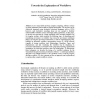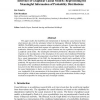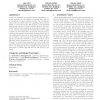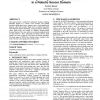197 search results - page 35 / 40 » Learning to Follow Navigational Directions |
EXACT
2009
13 years 5 months ago
2009
Across many fields involving complex computing, software systems are being augmented with workflow logging functionality. The log data can be effectively organized using declarativ...
JMLR
2010
13 years 2 months ago
2010
This paper studies the feasibility and interpretation of learning the causal structure from observational data with the principles behind the Kolmogorov Minimal Sufficient Statist...
KDD
2004
ACM
14 years 8 months ago
2004
ACM
In order to effectively use machine learning algorithms, e.g., neural networks, for the analysis of survival data, the correct treatment of censored data is crucial. The concordan...
ATAL
2005
Springer
14 years 1 months ago
2005
Springer
2. THE MASM ALGORITHM An input to the MASM algorithm is a time-annotated multi-agent action sequence. The action sequence is then transformed into an action graph. An action graph ...
FGR
2002
IEEE
14 years 20 days ago
2002
IEEE
We present ongoing work on a project for automatic recognition of spontaneous facial actions. Spontaneous facial expressions differ substantially from posed expressions, similar t...




